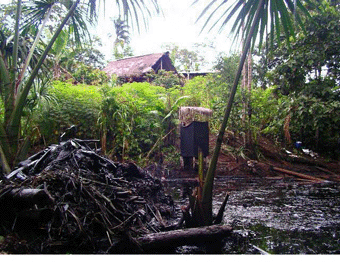In 1964, Chevron, then Texaco, headed oil exploitation in the Ecuadorian Amazon region. AmazonWatch reports that when the company left in 1992 it left behind 627 oil pools which still leak toxins and that it dumped highly toxic waste in the Amazon equal to 30 Exxon Valdez spills.
Despite these catastrophic facts, during one of the site inspections, a Chevron lawyer spoke of the "dignity" and "honor" of the corporation and mostly blamed all of the contamination on the inhabitants of the Amazon and the Ecuadorian state oil company Petroecuador, which took over some, but far from all, of Texaco´s operations in 1993.
My colleagues and I trekked across pipelines, passed by a huge recent oil spill by Petroecuador (which was of course used by Chevron´s lawer as part of their defense against contamination), on this gloomy days outside of Lago Agrio (the city named by Texan oil workers) during judicial inspections at Pozo 6, or oil well 6. A reporter from the Washington Times spoke to us about the copies of contracts he had in his briefcase which outlined several agreements between Chevron and the Ecuadorian military, and he could not believe the play put on by Chevron´s lawyer. It was an absurd theater of law where race and gender played a special role.

It was absurd to think that we, as white women, had the right to observe the pleadings as well the gathering of oil and soil samples as evidence in the judicial inspections in this case, when Cofan indigenous people, as landowners affected by the contamination, had been refused to speak at previous inspections. A man from Chevron´s "team" asked me where I was from and then went on to inform me that his team (all mostly white men) was international as well, and included people from Peru, the U.S., Colombia, and Ecuador.
The plaintiffs’ lawyer Pablo Fajardo presented evidence of the crimes committed by Chevron. He represents the 30,000 affected in this case, which includes five indigenous groups, the Siona, Secoya, Cofanes, Huaorani, and Quichua who are threatened by extinction, as well as mestizo or "colono" (colonizer) communities.
Emergildo Criollo, leader of the Cofan organization FEINCE which represents the 10 Cofan communities, was also present on this day (Dec. 1) to observe the inspections. Later we had the chance to speak to him personally to ask about the plight and the resistance of his people. He denounced Texaco´s contamination including how the Ecuadorian government welcomes oil exploitation in the Amazon with open arms. He told us how Texaco was the first oil corporation to operate in the Amazon and how crude oil was used to pave roads in the area which led his people to suffer many illnesses. He had witnessed the first road built between Coca and Lago Agrio (towns created solely due to oil) in 1973 that was covered in crude oil. For example, the women had misscarriages and deformations which they never suffered before.
He described the social ills that oil has created in the communities, such as the dependence of money that was unnecessary before when they could fish and hunt. Now, fishing and hunting is reduced, due to contamination and deforestation. According to Emergildo, colonizers (Ecuatorian mestizos that have moved to the region with support from the government) have also recently entered their reserve to hunt, and the Cofanes are now organizing to protect the animals and the rain forest. They now have to survive from selling hand crafts since there are no other jobs. When asked about his opinion in the case against Texaco, he answered that at first thought, he thinks the communities will lose the case but then when he sees the evidence he has more hope.
But if they don’t win, he worries about whether the environment will ever be cleaned up.
The 30,000 defendants’ lawyer Pablo Fajardo made his case against Texaco in front of the judge. In green, Emergildo Criollo, the leader of the Cofanes indigenous people observed the judicial inspections that he hopes will make Texaco take responsibility for the many illnesses of his people and the destruction of the environment.
Hanna Dahlstrom currently works in Ecuador for the Swedish NGO UBV.
